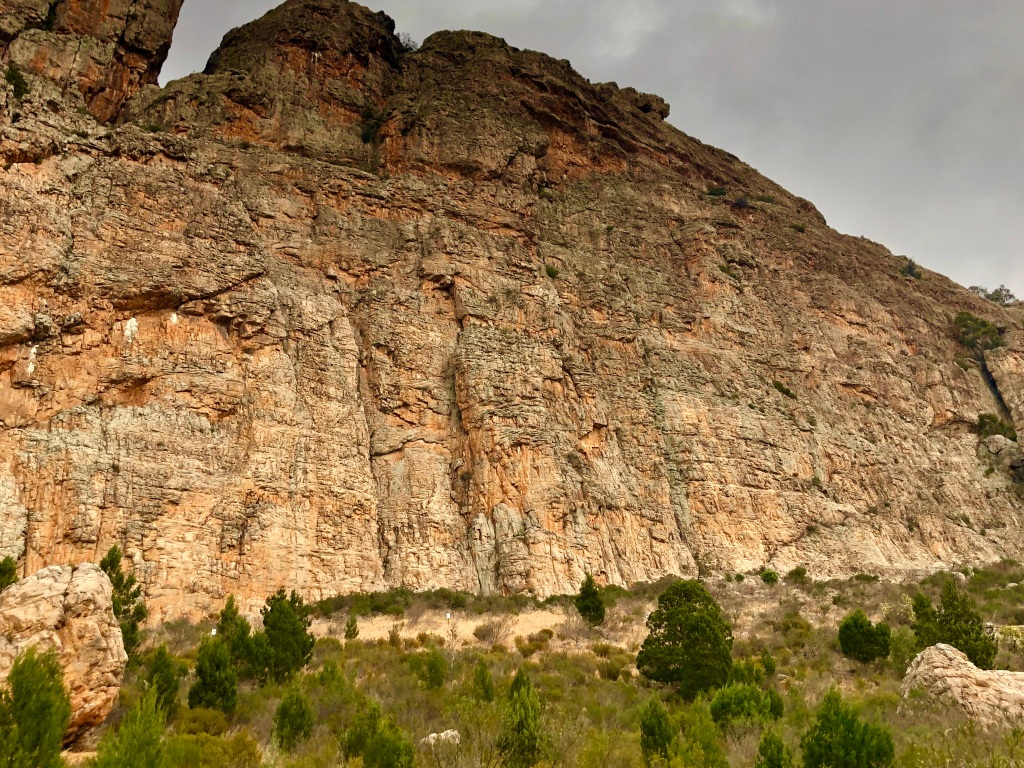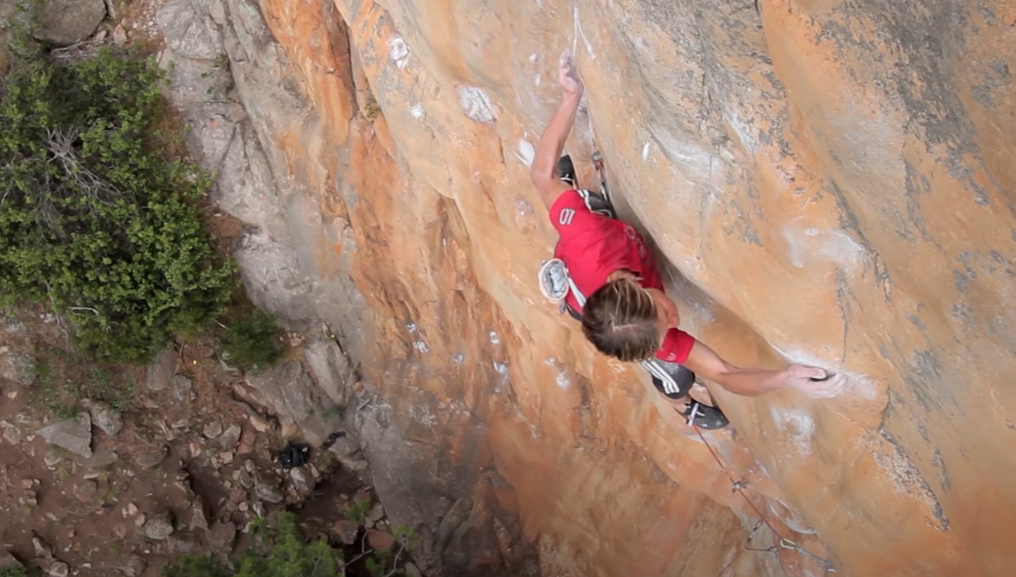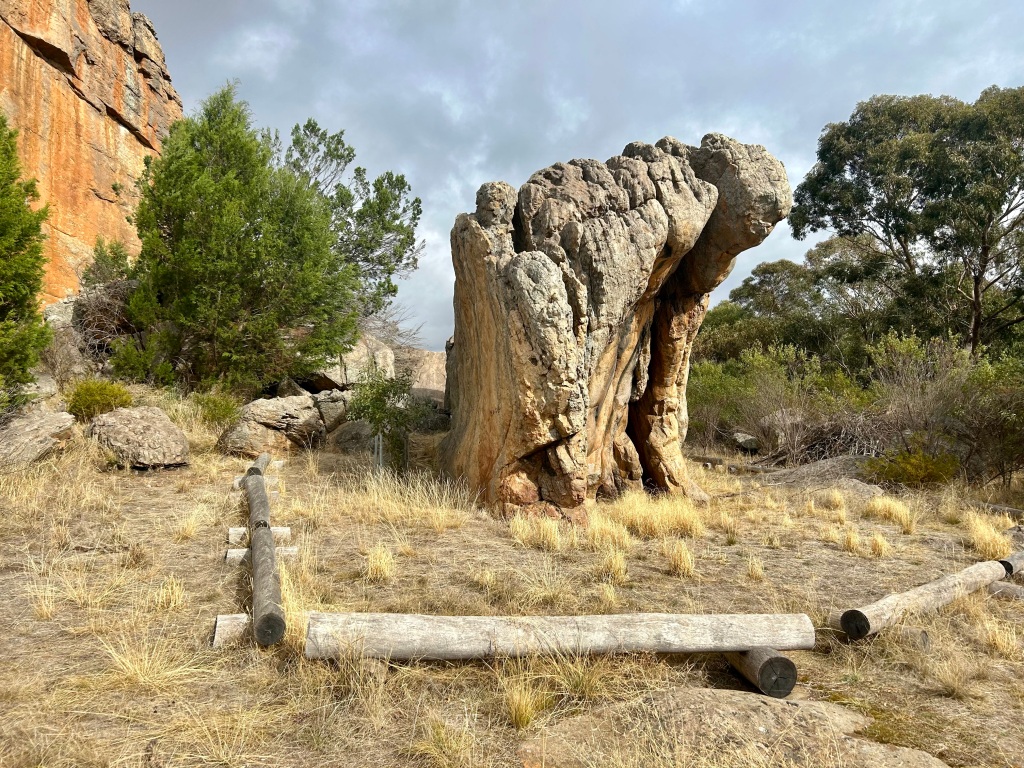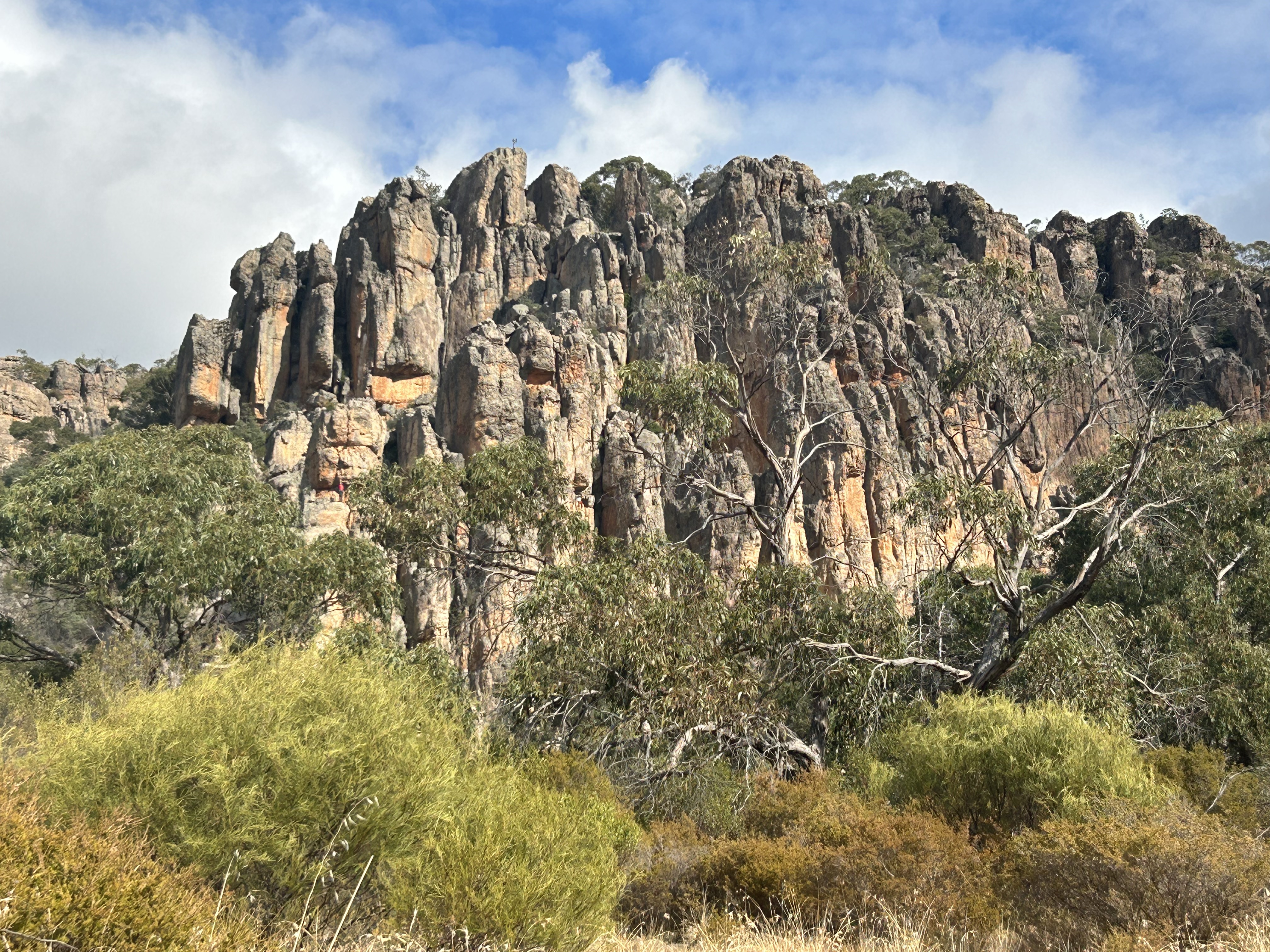
The Mount. Not crowning a crop of canola during our latest visit, but it still has its moods.



The last one above was taken on the same day as the extraordinary aurora australis lightshows of mid-May. If we’d been at the right place (nearby) at the right time (later) that night we could have seen this. [Thank you Angela Williams.]
But instead it was just a good old Wimmera sunset.

Mount Arapiles or Dyurrait (pron. ‘djoo-rid’) can be considered as one end of the Great Dividing Range around 3800 kms from the other, Dauan Island in Torres Strait. It is an outlier from the Grampians about 50 kilometres north-westerly from Mount Zero and was originally composed of the same material, layers of sediment which have cemented into sandstone. But around 400 million years ago there was a volcanic incursion below this particular area the effects of which transformed the rock into quartzite, something considerably more durable. And so while over time its surrounds have eroded away The Mount has remained, a vertical feature in flatlands. It is modestly-scaled, about 300m. above sea level and at its highest only 140m. above the surrounding plain.

Its identity is commonly defined by its eastern profile which includes a series of quite dramatic cliffs, more orange than they appear above. And just while we’re there the three white marks, bird shit stains, on the left hand side of the photo indicate nests of peregrine falcons. But it also has a back (see below), graceful spurs filling out something closer to a circle. (And a golf course belonging to the Natimuk Golf Club is cut into its southern flank.)


The Major (Thomas Mitchell) was the first interloper to climb The Mount: 23 July 1836. He was on his way to the south coast but noted that this ‘remarkable portion of the earth’s surface’ was worth a detour for the commanding and uninterrupted views it provided. He called it Arapiles after some hills in which he had fought during the Battle of Salamanca in central Spain. Like ‘Grampians’, it is, I fear, another example of his tin ear for naming. The Djurid Baluk clan of the Wotjobaluk people who had lived here and hereabouts for thousands of years called it Djurid which for whatever reason, and I’m sure it’s a good one, is rendered now by the Victorian Aboriginal Corporation for Languages as Dyurrait.
It would not have tested his climbing abilities. The ground cover is relatively open. There is a long gully in the eastern face with a track in it now that would have taken him pretty close to the, again, modest summit. But even if he’d tackled the rock he would have found it most accommodating.
What’s the big deal about Arapiles? It’s a climber’s paradise.
* * * * * * * *

‘What can I say about Arapiles that hasn’t already been said a thousand times before? Very little I fear! Many a would-be writer has waxed lyrical about the magic of Victoria’s climbing Mecca, the premier destination, possibly the very heart and soul of traditional climbing in Australia. Too much? Okay, so we all know it’s the bees knees, that it fills the dreams of climbers world wide, inspires many a new comer to take up the sharp end, and causes Melburnians to get up at ungodly hours of the morning to make the mad 4 hour rush to The Pines campground, just so they can be at the front of the queue on the Bard.’
This comes from Chockstone a very active climbers’ website which, inter many alia, provides guidance for people who want to climb. The accompanying photo is from a climb called ‘Kachoong’. Climbs all have their own often obscure names, an integral part of climbing’s own distinctive argot. A small sample of The Mount’s routes: Henry Bolte, Lord of the Rings, Oceanoid, Eurydice, Reaper, Required, Denim, Squeakeasy, John and Betty, D Minor and Braindrops.
The writer goes on to say:
‘Arapiles is home to over 2000 quality routes, condensed into one, and let’s be honest, fairly small mountain. [Elsewhere I have see this number as 3271, with 153,987 recorded climbs.] There are climbs within a stones throw of the famous Pines campground, and you don’t have to walk far at all to access hundreds of worthwhile routes. Basically if you can’t find a line you like at Araps, then you’re in the wrong sport. The rock is super strong sandstone, that really lends itself to solid nut placements. The climbing is essentially all traditionally protected. There are a few bolts around, but they’re mainly on the harder stuff, and only in places where natural gear won’t suffice. If you turn up with a power drill and rack of draws [a large collection of rope clips], you’ll likely be strung from the nearest tree and fed to the blue tongue lizards!’
Super strong sandstone, full of ‘jugs’, short for ‘jug handles’, large easy holds which won’t crumble. After climbing up both sides of Mitre Rock, I can attest to that. There is something to it that seems to draw you on. Even old farts like me. But this is what it can mean: a young man called Ryan writing in Exurbia, the mag of an organisation which supports Scouting in South Australia.
‘For me, climbing is my life, my world. I live it, I breathe it, I need it to function. Through the ups and downs of life, through some fantastic times of joy, unforgettable trips and lifelong friends and equally through some truly dark and depressing times, climbing has been the one constant in my life, the one thing that I can fall back on – like a warm embrace from a friend – and rediscover myself. … While climbing has been the centre of my life, so too has Arapiles been the centre of my climbing.
It is a place I’ve always felt at home. The rest of the world doesn’t exist out here. Angry horns and shouts of city traffic are replaced by a chorus of kookaburras, magpies and rosellas. Concrete pavement by open shrubland on which kangaroos graze peacefully. And hurried people all demanding different things from you – trying to get you to open up, or change to something you know you aren’t – is replaced by a tight-knit and wondrous little community of like-minded souls from all walks of life. Different cultures, different backgrounds, different personalities all camping together, climbing together, laughing together, unified and connected by this magical little cliff in the middle of nowhere.
At Arapiles, I feel like I can be myself, unjudged and unbound by the rest of society. Onsighting classic trad routes [climbing without ‘beta’, preparation, or fixed support] on glorious orange rock, projecting [working on, pouring time and effort into] hard in the dark and dingy gullies in between. … I don’t feel lost out here, I feel free.
Then there was this most recent trip.
I had a month at the Mount, and just like my previous trip to Tasmania, I was on my own with no real plan. I just wanted to escape the city and get back into enjoying climbing after a tough few months off with a major finger injury. I was drawn to a route called ‘Final Departure’ – a vaunted grade 27 sport climb high up on the proudest part of the mount, overlooking the entire campground. It’s long, sustained, and very hard for the grade. [All climbs in the ‘sport’ are graded. Recently two guys have climbed like flies across the roofs of giant caves and it is agreed that these climbs, currently the hardest in the world should be graded 5.15c (American) or 38 (Australian). Completion of such climbs, or ‘sending’ them in the argot, is staggeringly rare and it might take 6-8 months effort to achieve them. ’27’ is deemed ‘expert’.]
I had no plans to attempt the climb initially – climbing of that grade wasn’t something I was even considering after being injured for so long – but some friends of mine were projecting it [see above] and I jokingly decided to give it a go.
Much to my surprise, the majority of the moves came together quite easily, and on my third session I’d solved the crux sequence [the hardest part] high in the route – a sustained and very intricate sequence of bad [difficult] side-pulls and lots of small, technical foot moves – but knew that to link it all together would still take a lot of work.
I decided to take some rest and two days later woke to an avian dawn chorus. … I closed my eyes and visualised the moves I needed to do. A strange self-confidence came over me – something that I’ve always struggled with throughout my entire climbing career – and I opened my eyes, focused on the chalk of the crux holds and whispered to myself: ‘This is going down today.’
A few hours later I was at the base of the climb, tied in and ready to go. I had warmed up and was feeling good. The cliff was shaded and the wind was still. Everything was perfect.
I actually climbed pretty badly through the first half of the route. In the rest before the crux I was shaky, breathing heavily with anticipation. Even the crux itself was less than ideal. I didn’t stick the initial holds well, misplaced some feet and barely stuck a crucial left hand crimp [a hold with space only for your fingertips … or tip]. But once I stuck that hold, everything changed.
All that confidence, all that assurance and belief I’d felt that morning came rushing back, and all doubt was purged completely from my mind. It’s hard to describe, I just knew I could do the rest of the moves.
And I did. The remaining sequences were executed perfectly. Feet stayed on, hands didn’t open, the rope kept moving through the belay device.
Upon clipping the chains at the top, there was no outburst of emotion, no glorious cheers of victory, not even an exhale of relief. I just sat there, basking in a feeling I’d never once experienced in all my years of climbing. In that moment, everything faded. Mind and body become weightless. All the garbage in the world ceased to exist. Bills, deadlines, responsibilities, none of it mattered. All that was left was an entity – myself – existing in this exact point of space and time.’
Watch the video below to see what this could be like. For some time the hardest route in the world, ‘Punks in the Gym’ rated at 32 or 33, was on Arapiles, one of the reasons why it is world famous within this community.
Watch Mayan Smith-Gobat climb it, after 27 years the first female success. Click here. Seven mostly engrossing minutes.

At 5.13 she jumps, her left hand finding and holding The Birdbath, a crucial jug, really the only one on the way up. This is a manufactured hold originally chipped out of the rock by Swiss climber Martin Scheel who still couldn’t complete the climb (first ‘sent’ by Wolfgang Güllich in August 1985). Probably weakened by the nature of its construction, the hold broke off and another climber, Andy Pollitt, who spent 60 days on ‘Punks’ unsuccessfully, glued it back on. It has come off twice since and has been glued back each time. This is deeply atypical of Arapiles climbing, more a storied oddity. BUT it has happened.
As you watched Mayan climb you may have noticed two other things. One, it’s not alpine climbing. You’re not on your way up Everest. Although there is enormous variation, 40 to 100 metres often seems about the length of these sorts of routes. Second, there are chalk marks on this column.
* * * * * * * *
So far, so good. You might think. But then …
Grampians (Gariwerd) National Park is Victoria’s fourth largest national park and listed on Australia’s National Heritage List for its significant Aboriginal cultural heritage, fauna and flora diversity, landscapes, and protection of threatened species. A popular visitor destination for hiking, road touring, cycling, canoeing and birdwatching, the park is also well known for rock climbing. Parks Victoria and the Gariwerd Traditional Owners represented by Barengi Gadjin Land Council Aboriginal Corporation, Eastern Maar Aboriginal Corporation and Gunditj Mirring Traditional Owners Aboriginal Corporation released the Greater Gariwerd Landscape Management Plan in 2021. Opportunities for recreation, including rock climbing, have been identified within the management plan.
Designated climbing areas
Following extensive cultural heritage assessments, more than 100 rock climbing areas were identified in the national park, including 13 bouldering sites. Rock climbing can only occur in these designated areas. Changes to rock climbing management has occurred as part of a review of activities in the park, including extensive assessments to understand cultural and environmental values. Climbing outside of a designated climbing area can result in regulatory penalties. …
Responsible climbing in Gariwerd
- Rock climbing and bouldering can only occur in designated areas
- Rock climbers are responsible for assessing and accepting the risk associated in undertaking the activity within these areas
- Respect other climbers and park visitors
- Stick to established tracks and avoid damaging or removing vegetation where possible
- Minimise the use of chalk and only use chalk coloured to match the rock surface.
Although that has prohibited climbing in about 60 percent of the areas previously used and nearly 90 percent of bouldering opportunities that sounds not unreasonable. That’s the Grampians. It couldn’t apply to Arapiles, surely. Well as a matter of fact …
Aboriginal cultural heritage has been rediscovered at a number of locations in Mount Arapiles-Tooan State Park over the past 12 months. These rediscoveries are protected by legislation and are enormously important to Traditional Owners the Wotjobaluk, Jaadwa, Jadawadjali, Wergaia and Jupagulk peoples, who have occupied the lands around Mount Arapiles – known as Dyuritte – for thousands of years.
What are the rediscoveries?
Recent rediscoveries in the park include a large stone tool quarrying and manufacturing site which extends for around 200 metres along the areas known as Plaque Rock and Tiger Wall. This is where Traditional Owners produced a variety of stone tools for use in the immediate area and for trading with other Aboriginal groups. These include sharp-edged knives and spearheads for cutting and hunting, and flat stones for grinding down foods or crushing materials, such as to make pigments for painting.

There are so very many climbing routes at The Mount but a lot of them are on Plaque Rock and more especially the 200m of Tiger Wall some of which is pictured above. If you look again you might see some small rectangles of white. They’re signs saying you can’t climb here and, my goodness, there were a lot of them.


This superb rock, the same one from different directions, is in one of the protected areas. It is known as Taylor’s Rock with Declaration Crag behind it on the left. I think anyone with a flicker of imagination could see that it might have been significant for thousands of years. (And also that whoever might be suitably related to it probably isn’t Taylor.) I’m not quite sure why, and not that my opinion counts in any way, but I’m very confident about that.
The ‘quarry’ along the bottom of Tiger Wall? Well, less so.
The climbing community erupted as did The Australian with its vested interest in culture wars. It touted the prospect of fines of up to $346,000 for climbing in prohibited areas. These penalties do exist but for much more nefarious activities than climbing. The one source for these claims seems to have been John Ferguson, an Associate Editor of The Australian, who wrote about the issue much more thoughtfully and even-handedly than The Australian’s headlines would suggest.
The criticisms of climbers weren’t confined to cultural insensitivity. It was claimed that their chalk marks defaced cliff faces semi-permanently, that the pads used for bouldering (to fall off on to, and if you want to ‘boulder’ essential) damaged the bush irrevocably, that approaches to climbs were creating indiscriminate tracks and that climbers had been driving bolts into or near rock art (prolific in the Grampians). The evidence was investigated. Chalk does wash off as a rule and the faces examined were discovered to have white streaks which were just variant rock colours and in other places long-standing remnants of bird shit. The infamous bolt was found in the Cave of Hands at Billawin knee-high to the ground, a relic of a cage which had been built around paintings. But, even if it is an unusual example and it is, the eastern face of Arapiles/ Dyurrait has approach tracks everywhere and the bouldering pads have unquestionably left big bare patches at the most popular spots like the base of Mount Stapylton.
‘Save Grampians Climbing’ conducted a survey a few months after the promulgation of the new rules and legislation. One of the things that interested me was that of the 480 responses, a quarter described their work as being in the fields of science or engineering. Low affect? High focus? Strong rationality? Who knows. There was no other pattern whatsoever. An extraordinary range of people climb.
70 percent were in favour of a permit system coupled with education on cultural heritage and the environment as a way of maintaining access. More than 90 percent would climb with appropriately coloured or no chalk. Only a small number agreed with Parks Victoria that the placement of any further bolts should be banned; almost all respondents wanted the maintenance of the Victorian Climbing Club policy on bolts, three detailed pages the dominant theme of which is keep bolts to an unintrusive minimum. (Trad climbing, the form most practised at The Mount, generally disdains the use of non-natural protection.)
80 percent said they thought that the most successful strategy for regaining access was to ‘work with and gain the trust of Traditional Owners’.
The early public statements from Parks Victoria and the relevant Koori groups were, as I read them, quite conciliatory in nature. More recent statements have a hardened edge and still no indication of how much further bans might extend. It is obviously a political problem where there may in the end be no winners.
Here’s a reddit post from 18 months ago.
‘Most of you probably aren’t aware that Victoria is home to some of the best rock climbing in the world. The Grampians and Mt. Arapiles attract people from around the world.
Victoria is also home to some of the best preserved and abundant Aboriginal rock art and cultural sites in Australia, with 90% of it being found in Gariwerd and recent rediscoveries at Djurite.
As it happens these two things are very strongly overlapping in their locations. Humans have been drawn to these sites for millennia and continue to be so. There is something intangible but powerful when walking quietly in the eucalyptus after rain on a cool winter day, sitting on top of ancient rock observing the landscape, or sleeping on the ground and hearing the world around you.
I’ve spent a lot of time in these places. I know the shape of the land, the peaks of mountains from standing on them, and the texture of the rock at different locations. I feel a connection with this place. I am of European descent. Where is my place? England or wherever? No, it is here, and I want to be able to share it.
I have strong links and family ties to the Aboriginal community. I am respectful of the history and the people who were here first. I am sad about the past.
I am also a rock climber who fears we will lose something very, very special because of the bans that are in place and that are becoming larger. …
This issue began divided and has only got worse. There are people on both sides of the opinion spectrum who are taking a divisive position. When this happens climbers lose access to places that they care about, protect, and enjoy; Aboriginal groups lose the ability to have dialogue and share their history; and we all lose a part of what makes these places so special.
It doesn’t have to be either/or. I am an example of straddling the divide. These places are out here and they are amazing. If you haven’t been then come and see.’
This is followed by several hundred comments which are mainly invective and bile.
* * * * * * * *

We weren’t there to climb — just interested onlookers and there was plenty of climbing going on, disembodied voices coming through the cracks and gullies like some sorts of wraith — we were there for art.
We walked all the way round the bottom on one of the three days we spent there, a very fine walk largely confined to rough dirt roads, but my companion spent most of the time looking for ideas and inspiration.
The Mount provided.












Flame heath, Victoria’s floral emblem, growing out of a crack near the top of the northern stand of Mitre Rock, just caught by the late sun.
We could have stayed longer.
